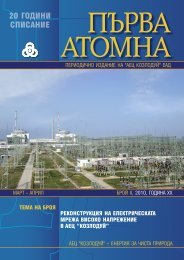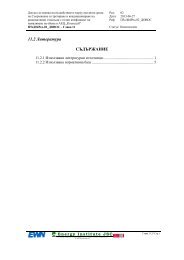Summary Report for Conduct of Kozloduy NPP Stress Tests
Summary Report for Conduct of Kozloduy NPP Stress Tests
Summary Report for Conduct of Kozloduy NPP Stress Tests
You also want an ePaper? Increase the reach of your titles
YUMPU automatically turns print PDFs into web optimized ePapers that Google loves.
“<strong>Kozloduy</strong> <strong>NPP</strong>” PLC<br />
SUMMARY REPORT<br />
<strong>for</strong> <strong>Conduct</strong> <strong>of</strong> <strong>Kozloduy</strong> <strong>NPP</strong><br />
<strong>Stress</strong> <strong>Tests</strong><br />
3 EXTERNAL FLOODINGS<br />
3.1 DESIGN BASIS<br />
The Bulgarian legislation in accordance with Section II, Article 29, paragraph 3 <strong>of</strong><br />
"Regulations <strong>for</strong> ensuring nuclear safety <strong>of</strong> nuclear power plants" provides the following wording<br />
<strong>of</strong> requirement <strong>for</strong> external flooding:<br />
"For the site <strong>of</strong> <strong>Kozloduy</strong> nuclear power plant the maximum water level and duration <strong>of</strong><br />
possible flooding in case <strong>of</strong> rainfall, intense snow melting, high water level in the reservoir,<br />
blocking <strong>of</strong> the river from ice, avalanche and landslide shall be determined; <strong>for</strong> K<strong>NPP</strong> site the<br />
features <strong>of</strong> maximum possible flood in the river spills with frequency 10-4 events per year is<br />
assessed in combination with the tide and waves caused by wind. According to [134] that all<br />
nuclear power plants located on sites where flooding is possible shall withstand the design MWL.<br />
The most appropriate design solution is the elevation <strong>of</strong> the plant and the safety related components<br />
above the MWL.<br />
3.1.1 Floodings against which the plant is designed<br />
The sources <strong>of</strong> potential external floodings are maximum possible natural water levels <strong>of</strong><br />
Danube River, destruction <strong>of</strong> the walls <strong>of</strong> water supply system “Iron gates”, accident on<br />
“Shishmanov Val”, slope waters from location “Marishkin Dol”, waters from tributary valley<br />
“Marichin Valog” and durative heavy rains in the plant site.<br />
3.1.2 Current reassessments <strong>of</strong> MWL<br />
3.1.2.1 Characteristics <strong>of</strong> the MWL reassessed<br />
In determining the maximum possible water level <strong>of</strong> Danube River both natural extreme<br />
water levels and water levels at the rupture <strong>of</strong> the two water supply systems "Iron Gate" 1 and 2 are<br />
considered. Separately, the impact <strong>of</strong> intense local rainfall, water retention due to ice drift and the<br />
<strong>for</strong>mation <strong>of</strong> waves when water enters the valley is also considered.<br />
Below options <strong>of</strong> potential flooding <strong>of</strong> the plant site, caused by potential rupture <strong>of</strong> the dam<br />
<strong>of</strong> lake "Shishmanov shaft", the slope water from "Marishkin Dol" or water from tributary valley<br />
“Marichini Valog” are also considered.<br />
3.1.2.1.1 Definition <strong>of</strong> MWL due to increase <strong>of</strong> Danube River level<br />
The design <strong>of</strong> the plant and three new studies relating to the determination and revaluation<br />
<strong>of</strong> the maximum water level (MWL), which can be reached at the plant site are discussed. For level<br />
0,00 at the plant site elevation 35.00 <strong>of</strong> Baltic altitude system was adopted.<br />
Initially, the maximum water levels <strong>of</strong> Danube River have been set in detailed design<br />
(Volume "Hydrology", 1972, and Volume "НОПТУ", May ,1975) at <strong>Kozloduy</strong> <strong>NPP</strong> water intake<br />
facilities at 687 km <strong>of</strong>:<br />
102/202

















